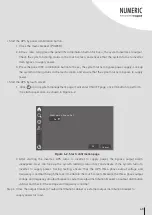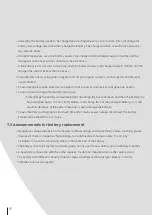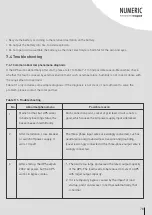
74
Step 4 Start each UPS. Ensure that all UPS stay in bypass power supply mode, and with no abnormal, switch
on the external distribution switch, switch off the UPS output switch, and start the inverter of each
UPS manually, all UPS turns to inverter power supply.
Step 5 Measure the output voltage and frequency of each UPS. After each UPS turns to inverter power supply
(user can check whether the system stay in inverter power supply mode through system running
status), check whether the UPS three-phase output voltage and frequency is normal by the real-time
data in touch screen, measure the front-end three-phase output voltage of output breaker of UPS,
ensure that the inverter output voltage is normal (the three-phase output voltage = output voltage
setting ±2.0 V), and ensure that the inverter frequency is normal (the three-phase output frequency =
output frequency setting ±0.1 Hz). Record the measured three-phase voltage effective value of each
UPS.
Step 6 Switch off the output breaker of one UPS and measure the voltage difference at the front and rear of
the output breaker in any other UPS, ensure that the corresponding phase voltage effective value
difference less than 5 V, and then parallel the UPS. If it does not meet the requirement, the UPS with
big voltage deviation cannot be put into parallel system and it is necessary to debug again.
Step 7 Shut down the inverter of the UPS. Ensure that there is no abnormal alarm in any of the UPS, shut
down each UPS manually. All UPS turn to bypass power supply.
Step 8 Check the bypass phase sequence.Close the output breaker of UPS 1 (ensure that the total breaker of
load is disconnected, or once the output breaker of UPS 1 is closed, it will supply power for load),
maintain the output breaker of other UPS’ is disconnected, keep the multimeter in AC position,
connect one terminal with the output breaker front-end phase-A of UPS 2, the other terminal connect
with the output breaker back-end phase-A of UPS 2, measure the voltage difference between
front-end and back-end of UPS 2 output breaker. Measure the voltage difference of phase-B and
phase-C in the same way. If the phase sequence is right, the voltage difference of each should be less
than 5 V; if the phase sequence is not right, there is at least one phase voltage difference greater than
5 V. Measure whether the bypass sequence of each paralleled UPS is right (when measured other
UPSs’ phase sequence, it doesn’t need to operate the breaker. Maintain the output of UPS1 is closed
and the output breaker of other UPSs are not closed). If all bypass phase sequence of all UPS are right,
proceed to the next step; if the phase sequence of any one UPS is not right, power off the system and
check the input and output wiring of each UPS is right.
Step 9 Close the output breaker of all UPS. Ensure that each UPS is with no abnormal, close the output
breaker of all UPS successively. Ensure that the output end of all UPS stays in parallel status.
Step 10 Start the inverter of each UPS. Ensure that the system is with no abnormal, manually start each UPS
successively. System starts inverter power supply. Monitor that there is no abnormal alarm.
Step 11 Shut down the inverter of each UPS. Ensure that each UPS is with no abnormal, shut down the
inverter of all UPS, the system turns to bypass power supply.
Step 12 Close the total output breaker of load. After the parallel system turns to bypass power supply, close
the total output breaker of load, system bypass supplies power for load.
Step 13 Start each UPS successively, the system turns to inverter power supply.
6.4.2 Shut down parallel system
If the system bypass is normal, after shutting down the UPS, the system will turn to bypass
power supply mode; if the system bypass is abnormal, after shutting down the UPS, the
system will turn to no output mode, the system output is outage.
Before shutting down, please ensure that load is closed and can endure the status of
power outage at any time.
CAUTION












































